Analysis of HR Issues and Collective Bargaining Agreement Reflection
VerifiedAdded on 2022/10/01
|6
|1415
|22
Report
AI Summary
This report is a reflection on human resource issues within a business context, specifically focusing on collective bargaining agreements. The student analyzes a case study involving a salon, Penelope Pitstop, and their need to address employee concerns within the framework of the Hair and Beauty Industry Award (2010). The report highlights the student's role in representing employee interests, particularly concerning working hours, termination, consultation, first aid, and breaks. The student emphasizes the importance of balancing employer and employee needs through negotiation and compromise, utilizing the integrative negotiation style to achieve a win-win outcome. The reflection covers the application of relevant legislation, negotiation strategies, and the lessons learned from the collective bargaining process, including the importance of compromise and the establishment of a fair working environment. The report concludes by reinforcing the significance of aligning workplace rules with legal requirements and ensuring employee involvement in decision-making processes.

Name 1
Reflection
Student’s Name
University
Date
Course
Reflection
Student’s Name
University
Date
Course
Paraphrase This Document
Need a fresh take? Get an instant paraphrase of this document with our AI Paraphraser
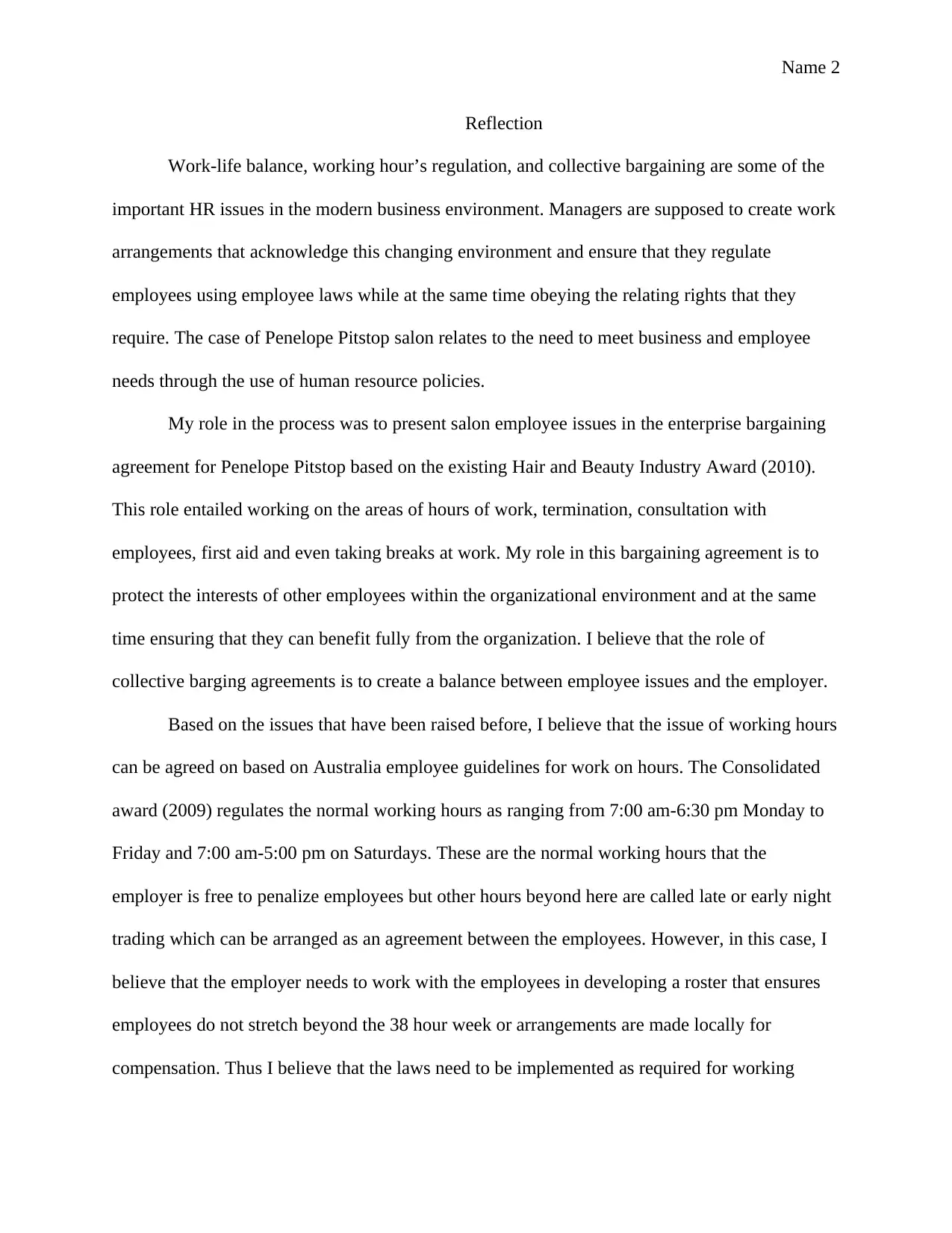
Name 2
Reflection
Work-life balance, working hour’s regulation, and collective bargaining are some of the
important HR issues in the modern business environment. Managers are supposed to create work
arrangements that acknowledge this changing environment and ensure that they regulate
employees using employee laws while at the same time obeying the relating rights that they
require. The case of Penelope Pitstop salon relates to the need to meet business and employee
needs through the use of human resource policies.
My role in the process was to present salon employee issues in the enterprise bargaining
agreement for Penelope Pitstop based on the existing Hair and Beauty Industry Award (2010).
This role entailed working on the areas of hours of work, termination, consultation with
employees, first aid and even taking breaks at work. My role in this bargaining agreement is to
protect the interests of other employees within the organizational environment and at the same
time ensuring that they can benefit fully from the organization. I believe that the role of
collective barging agreements is to create a balance between employee issues and the employer.
Based on the issues that have been raised before, I believe that the issue of working hours
can be agreed on based on Australia employee guidelines for work on hours. The Consolidated
award (2009) regulates the normal working hours as ranging from 7:00 am-6:30 pm Monday to
Friday and 7:00 am-5:00 pm on Saturdays. These are the normal working hours that the
employer is free to penalize employees but other hours beyond here are called late or early night
trading which can be arranged as an agreement between the employees. However, in this case, I
believe that the employer needs to work with the employees in developing a roster that ensures
employees do not stretch beyond the 38 hour week or arrangements are made locally for
compensation. Thus I believe that the laws need to be implemented as required for working
Reflection
Work-life balance, working hour’s regulation, and collective bargaining are some of the
important HR issues in the modern business environment. Managers are supposed to create work
arrangements that acknowledge this changing environment and ensure that they regulate
employees using employee laws while at the same time obeying the relating rights that they
require. The case of Penelope Pitstop salon relates to the need to meet business and employee
needs through the use of human resource policies.
My role in the process was to present salon employee issues in the enterprise bargaining
agreement for Penelope Pitstop based on the existing Hair and Beauty Industry Award (2010).
This role entailed working on the areas of hours of work, termination, consultation with
employees, first aid and even taking breaks at work. My role in this bargaining agreement is to
protect the interests of other employees within the organizational environment and at the same
time ensuring that they can benefit fully from the organization. I believe that the role of
collective barging agreements is to create a balance between employee issues and the employer.
Based on the issues that have been raised before, I believe that the issue of working hours
can be agreed on based on Australia employee guidelines for work on hours. The Consolidated
award (2009) regulates the normal working hours as ranging from 7:00 am-6:30 pm Monday to
Friday and 7:00 am-5:00 pm on Saturdays. These are the normal working hours that the
employer is free to penalize employees but other hours beyond here are called late or early night
trading which can be arranged as an agreement between the employees. However, in this case, I
believe that the employer needs to work with the employees in developing a roster that ensures
employees do not stretch beyond the 38 hour week or arrangements are made locally for
compensation. Thus I believe that the laws need to be implemented as required for working
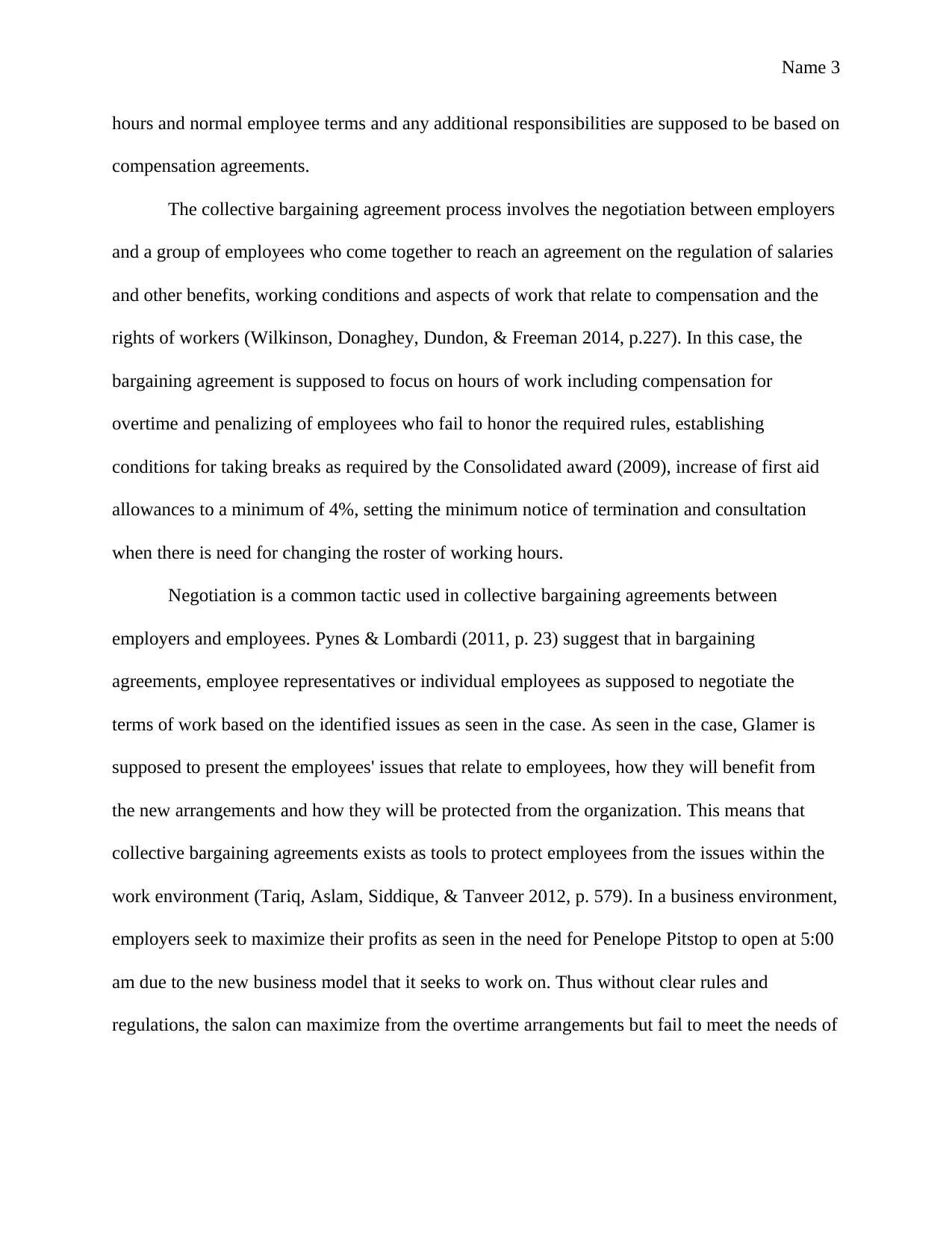
Name 3
hours and normal employee terms and any additional responsibilities are supposed to be based on
compensation agreements.
The collective bargaining agreement process involves the negotiation between employers
and a group of employees who come together to reach an agreement on the regulation of salaries
and other benefits, working conditions and aspects of work that relate to compensation and the
rights of workers (Wilkinson, Donaghey, Dundon, & Freeman 2014, p.227). In this case, the
bargaining agreement is supposed to focus on hours of work including compensation for
overtime and penalizing of employees who fail to honor the required rules, establishing
conditions for taking breaks as required by the Consolidated award (2009), increase of first aid
allowances to a minimum of 4%, setting the minimum notice of termination and consultation
when there is need for changing the roster of working hours.
Negotiation is a common tactic used in collective bargaining agreements between
employers and employees. Pynes & Lombardi (2011, p. 23) suggest that in bargaining
agreements, employee representatives or individual employees as supposed to negotiate the
terms of work based on the identified issues as seen in the case. As seen in the case, Glamer is
supposed to present the employees' issues that relate to employees, how they will benefit from
the new arrangements and how they will be protected from the organization. This means that
collective bargaining agreements exists as tools to protect employees from the issues within the
work environment (Tariq, Aslam, Siddique, & Tanveer 2012, p. 579). In a business environment,
employers seek to maximize their profits as seen in the need for Penelope Pitstop to open at 5:00
am due to the new business model that it seeks to work on. Thus without clear rules and
regulations, the salon can maximize from the overtime arrangements but fail to meet the needs of
hours and normal employee terms and any additional responsibilities are supposed to be based on
compensation agreements.
The collective bargaining agreement process involves the negotiation between employers
and a group of employees who come together to reach an agreement on the regulation of salaries
and other benefits, working conditions and aspects of work that relate to compensation and the
rights of workers (Wilkinson, Donaghey, Dundon, & Freeman 2014, p.227). In this case, the
bargaining agreement is supposed to focus on hours of work including compensation for
overtime and penalizing of employees who fail to honor the required rules, establishing
conditions for taking breaks as required by the Consolidated award (2009), increase of first aid
allowances to a minimum of 4%, setting the minimum notice of termination and consultation
when there is need for changing the roster of working hours.
Negotiation is a common tactic used in collective bargaining agreements between
employers and employees. Pynes & Lombardi (2011, p. 23) suggest that in bargaining
agreements, employee representatives or individual employees as supposed to negotiate the
terms of work based on the identified issues as seen in the case. As seen in the case, Glamer is
supposed to present the employees' issues that relate to employees, how they will benefit from
the new arrangements and how they will be protected from the organization. This means that
collective bargaining agreements exists as tools to protect employees from the issues within the
work environment (Tariq, Aslam, Siddique, & Tanveer 2012, p. 579). In a business environment,
employers seek to maximize their profits as seen in the need for Penelope Pitstop to open at 5:00
am due to the new business model that it seeks to work on. Thus without clear rules and
regulations, the salon can maximize from the overtime arrangements but fail to meet the needs of
⊘ This is a preview!⊘
Do you want full access?
Subscribe today to unlock all pages.

Trusted by 1+ million students worldwide
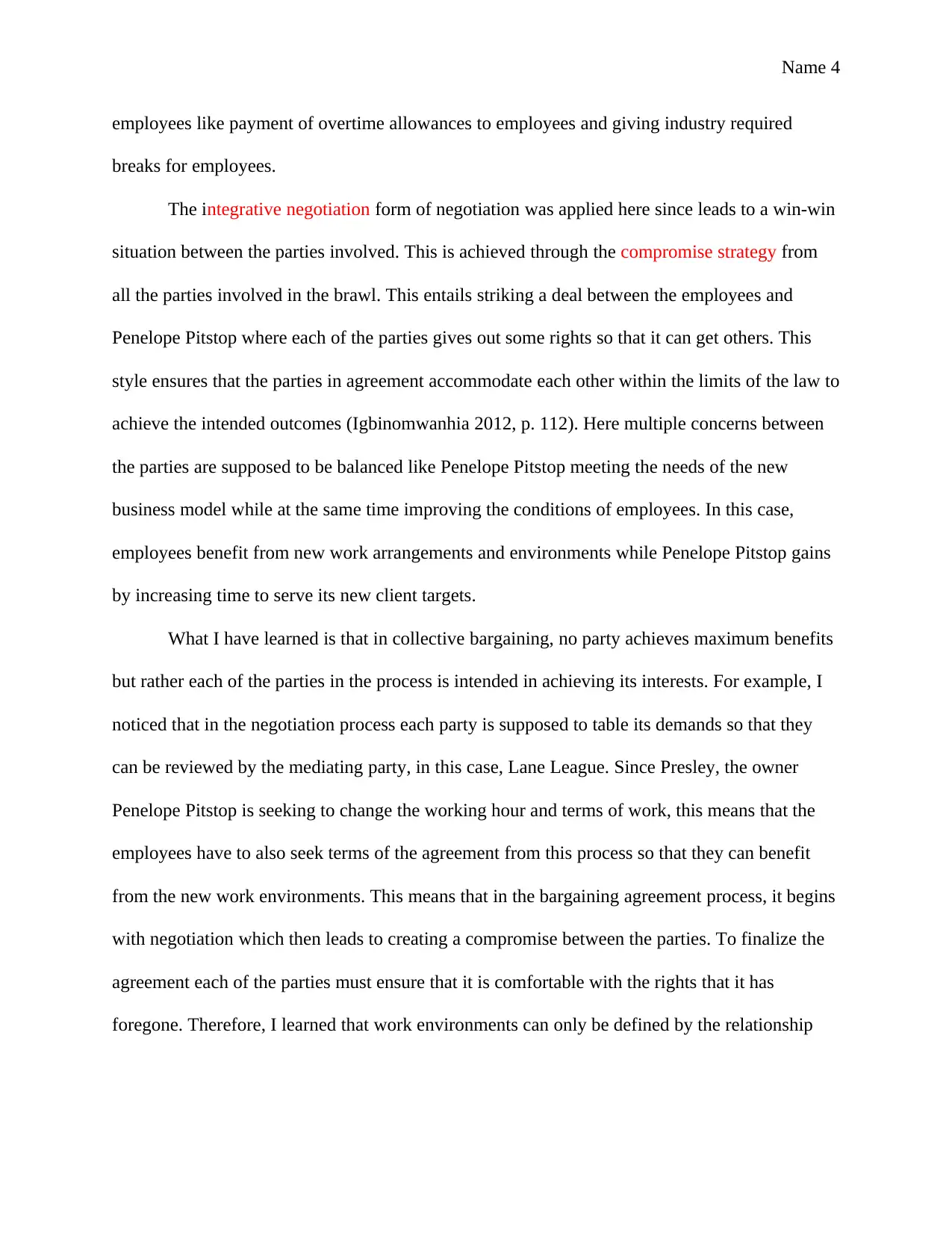
Name 4
employees like payment of overtime allowances to employees and giving industry required
breaks for employees.
The integrative negotiation form of negotiation was applied here since leads to a win-win
situation between the parties involved. This is achieved through the compromise strategy from
all the parties involved in the brawl. This entails striking a deal between the employees and
Penelope Pitstop where each of the parties gives out some rights so that it can get others. This
style ensures that the parties in agreement accommodate each other within the limits of the law to
achieve the intended outcomes (Igbinomwanhia 2012, p. 112). Here multiple concerns between
the parties are supposed to be balanced like Penelope Pitstop meeting the needs of the new
business model while at the same time improving the conditions of employees. In this case,
employees benefit from new work arrangements and environments while Penelope Pitstop gains
by increasing time to serve its new client targets.
What I have learned is that in collective bargaining, no party achieves maximum benefits
but rather each of the parties in the process is intended in achieving its interests. For example, I
noticed that in the negotiation process each party is supposed to table its demands so that they
can be reviewed by the mediating party, in this case, Lane League. Since Presley, the owner
Penelope Pitstop is seeking to change the working hour and terms of work, this means that the
employees have to also seek terms of the agreement from this process so that they can benefit
from the new work environments. This means that in the bargaining agreement process, it begins
with negotiation which then leads to creating a compromise between the parties. To finalize the
agreement each of the parties must ensure that it is comfortable with the rights that it has
foregone. Therefore, I learned that work environments can only be defined by the relationship
employees like payment of overtime allowances to employees and giving industry required
breaks for employees.
The integrative negotiation form of negotiation was applied here since leads to a win-win
situation between the parties involved. This is achieved through the compromise strategy from
all the parties involved in the brawl. This entails striking a deal between the employees and
Penelope Pitstop where each of the parties gives out some rights so that it can get others. This
style ensures that the parties in agreement accommodate each other within the limits of the law to
achieve the intended outcomes (Igbinomwanhia 2012, p. 112). Here multiple concerns between
the parties are supposed to be balanced like Penelope Pitstop meeting the needs of the new
business model while at the same time improving the conditions of employees. In this case,
employees benefit from new work arrangements and environments while Penelope Pitstop gains
by increasing time to serve its new client targets.
What I have learned is that in collective bargaining, no party achieves maximum benefits
but rather each of the parties in the process is intended in achieving its interests. For example, I
noticed that in the negotiation process each party is supposed to table its demands so that they
can be reviewed by the mediating party, in this case, Lane League. Since Presley, the owner
Penelope Pitstop is seeking to change the working hour and terms of work, this means that the
employees have to also seek terms of the agreement from this process so that they can benefit
from the new work environments. This means that in the bargaining agreement process, it begins
with negotiation which then leads to creating a compromise between the parties. To finalize the
agreement each of the parties must ensure that it is comfortable with the rights that it has
foregone. Therefore, I learned that work environments can only be defined by the relationship
Paraphrase This Document
Need a fresh take? Get an instant paraphrase of this document with our AI Paraphraser
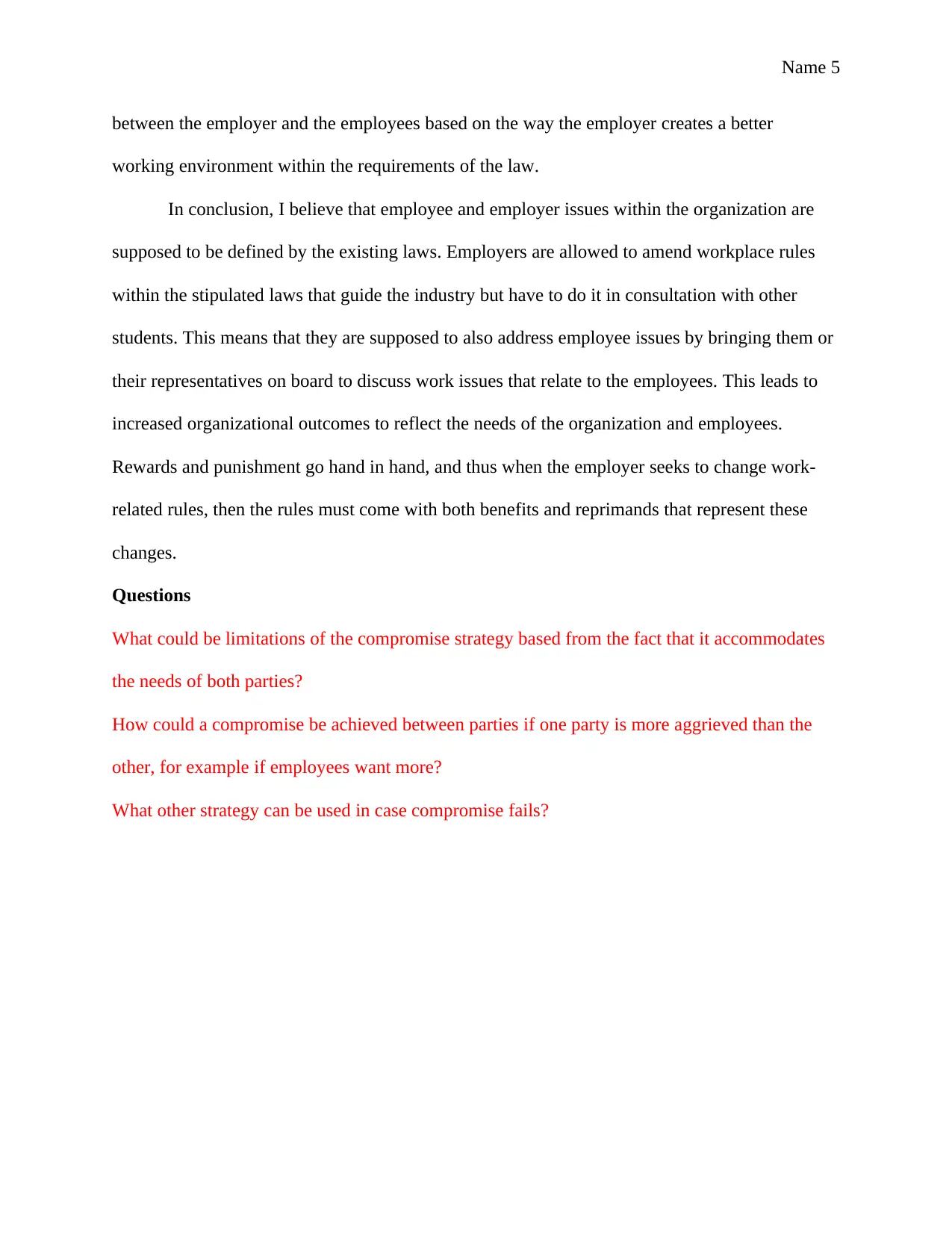
Name 5
between the employer and the employees based on the way the employer creates a better
working environment within the requirements of the law.
In conclusion, I believe that employee and employer issues within the organization are
supposed to be defined by the existing laws. Employers are allowed to amend workplace rules
within the stipulated laws that guide the industry but have to do it in consultation with other
students. This means that they are supposed to also address employee issues by bringing them or
their representatives on board to discuss work issues that relate to the employees. This leads to
increased organizational outcomes to reflect the needs of the organization and employees.
Rewards and punishment go hand in hand, and thus when the employer seeks to change work-
related rules, then the rules must come with both benefits and reprimands that represent these
changes.
Questions
What could be limitations of the compromise strategy based from the fact that it accommodates
the needs of both parties?
How could a compromise be achieved between parties if one party is more aggrieved than the
other, for example if employees want more?
What other strategy can be used in case compromise fails?
between the employer and the employees based on the way the employer creates a better
working environment within the requirements of the law.
In conclusion, I believe that employee and employer issues within the organization are
supposed to be defined by the existing laws. Employers are allowed to amend workplace rules
within the stipulated laws that guide the industry but have to do it in consultation with other
students. This means that they are supposed to also address employee issues by bringing them or
their representatives on board to discuss work issues that relate to the employees. This leads to
increased organizational outcomes to reflect the needs of the organization and employees.
Rewards and punishment go hand in hand, and thus when the employer seeks to change work-
related rules, then the rules must come with both benefits and reprimands that represent these
changes.
Questions
What could be limitations of the compromise strategy based from the fact that it accommodates
the needs of both parties?
How could a compromise be achieved between parties if one party is more aggrieved than the
other, for example if employees want more?
What other strategy can be used in case compromise fails?
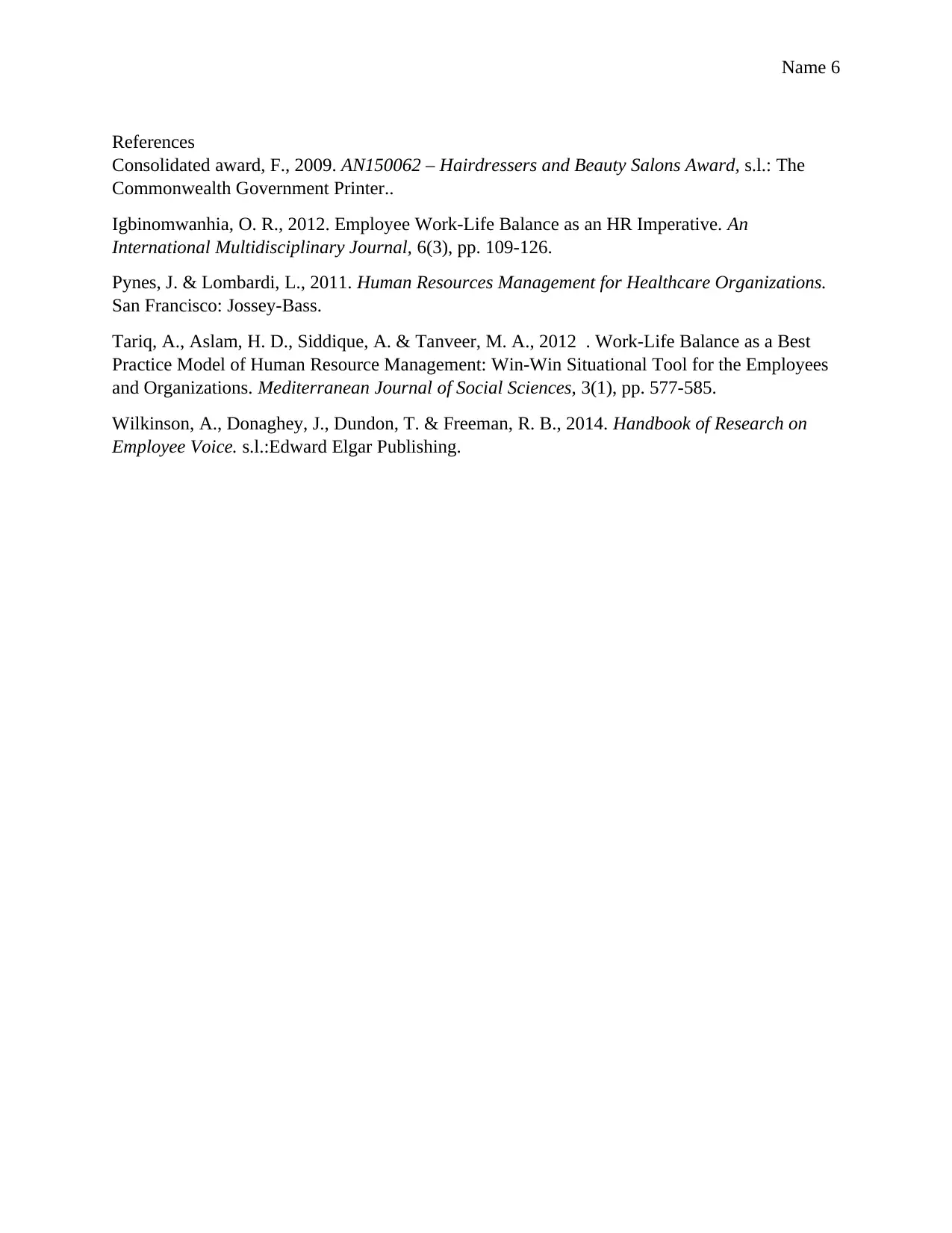
Name 6
References
Consolidated award, F., 2009. AN150062 – Hairdressers and Beauty Salons Award, s.l.: The
Commonwealth Government Printer..
Igbinomwanhia, O. R., 2012. Employee Work-Life Balance as an HR Imperative. An
International Multidisciplinary Journal, 6(3), pp. 109-126.
Pynes, J. & Lombardi, L., 2011. Human Resources Management for Healthcare Organizations.
San Francisco: Jossey-Bass.
Tariq, A., Aslam, H. D., Siddique, A. & Tanveer, M. A., 2012 . Work-Life Balance as a Best
Practice Model of Human Resource Management: Win-Win Situational Tool for the Employees
and Organizations. Mediterranean Journal of Social Sciences, 3(1), pp. 577-585.
Wilkinson, A., Donaghey, J., Dundon, T. & Freeman, R. B., 2014. Handbook of Research on
Employee Voice. s.l.:Edward Elgar Publishing.
References
Consolidated award, F., 2009. AN150062 – Hairdressers and Beauty Salons Award, s.l.: The
Commonwealth Government Printer..
Igbinomwanhia, O. R., 2012. Employee Work-Life Balance as an HR Imperative. An
International Multidisciplinary Journal, 6(3), pp. 109-126.
Pynes, J. & Lombardi, L., 2011. Human Resources Management for Healthcare Organizations.
San Francisco: Jossey-Bass.
Tariq, A., Aslam, H. D., Siddique, A. & Tanveer, M. A., 2012 . Work-Life Balance as a Best
Practice Model of Human Resource Management: Win-Win Situational Tool for the Employees
and Organizations. Mediterranean Journal of Social Sciences, 3(1), pp. 577-585.
Wilkinson, A., Donaghey, J., Dundon, T. & Freeman, R. B., 2014. Handbook of Research on
Employee Voice. s.l.:Edward Elgar Publishing.
⊘ This is a preview!⊘
Do you want full access?
Subscribe today to unlock all pages.

Trusted by 1+ million students worldwide
1 out of 6
Your All-in-One AI-Powered Toolkit for Academic Success.
+13062052269
info@desklib.com
Available 24*7 on WhatsApp / Email
![[object Object]](/_next/static/media/star-bottom.7253800d.svg)
Unlock your academic potential
Copyright © 2020–2025 A2Z Services. All Rights Reserved. Developed and managed by ZUCOL.